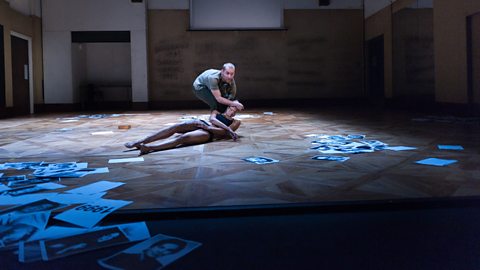Generating interesting and theatrical content and style
It is important to experiment with different styleHow theatrical ideas are presented on stage. of performance. It could be theatrical, with lots of different dramatic techniqueA way of presenting drama to make it more interesting for an audience., or a piece of physical theatreA mime technique in which actors use their bodies to create props or part of the set. with lots of movement and non-verbal communication. By researching dramatic styles it will become clear what will work best for each individual story to be told to an audience. By employing a range of techniques, interest can be added for the audience.

Ideas to consider might include:
- experimenting with time frames through use of flashbackA scene enacting something that happened in the past; the enactment of a character's memory of a past event. and flashforwardA scene enacting something that could happen in the future for the characters, or something that they imagine might be possible.
- performing a range of roles through multi-role playWhen a performer plays more than one character in the piece of devised work.
- trying out choral speechA speech spoken by more than one person. Can be spoken in unison or with words and phrases repeated or echoed through the speech. as a group to get across important messages
- direct addressWhen a speaker or writer directly addresses another individual. and narrationThe retelling of a story. to your audience so you create an extra impact on them
- trying a moment in slow motionWhen movement and action is deliberately performed slowly in order to draw attention to the moment. or at high speed to contrast with other parts of the piece
Do not underestimate the importance and impact of stillness and silence - the inclusion of these can have varying effects on an audience and work especially well to add tension or impact.
Other ideas to try out might include:
- changing the order of events to make the structureThe way a text is built and shaped. Chapters, plot, acts, scenes, stanzas, narrative, verse form, rhyme and rhythm are all aspects of structure. more interesting
- trying out monologueA speech by a single person, speaking alone, often revealing something about their past or personality. for different characters
- using music and devising a short section of mimeActing through body movement without the use of speech. to accompany this
- experimenting with your use of space and levelsLevels can be created through position of the body, set or staging. They show action in a different place/time and can reflect relationships. within the performance space
- doing something at the same time in synchronisingMaking two or more things occur at the same time. to emphasise the scene
Staging should be considered carefully, thinking about where the audience will be. Staging is important to make the relationship between performer and audience more exciting, and there are a range of staging configurations available, eg thrust stagingWhen the audience surround the stage on three sides, and the other side connects to the backstage area., promenade stagingWhen the audience can move around and follow the action during a performance., in the round stagingWhen the audience are placed all around the outside of the performers' playing space. The stage area may be circular or square, with entrances and exits through the audience. and end-on stagingWhen the audience sit on one side of the stage only, facing it in the same direction.. A configuration should be selected depending on its suitability to the piece.
More guides on this topic
- Developing an idea - AQA
- Selecting a genre or performance style - AQA
- Selecting a practitioner - AQA
- Rehearsing for a performance - AQA
- Refining a performance - AQA
- Interpreting and performing a character - AQA
- Designing a production - AQA
- Health and safety considerations - AQA
- Creating a portfolio or devising log - AQA